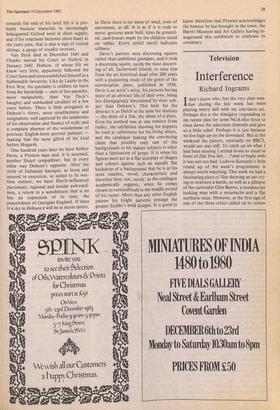Art
Face to face
John McEwen
William Dobson 1611-46, The Royalists at War (National Portrait Gallery till 8 January 1984) Polite Society: portraits of the English Country Gentleman and his Family by Arthur Devis 1712-1787 (National Portrait Gallery till 29 January 1984)
Contemporary portrait painting is pro- bably in as parlous a state as it has ever been, but as if to compensate we have contrived a golden age of portrait exhibi- tions. Gainsborough, Sargent, Lawrence, the miniaturists, even a forgotten contem- porary like Meredith Frampton, have all been the subject of first-time or un- precedentedly scholarly surveys, and now — unfortunately over-egging the omelette 0 bit — the National Portrait Gallery give5 inaugural surveys to two of our most ill' teresting, Dobson and Devis, at the salve time.
The '17th-century portrait has been a5 well served by exhibition as any other in the current round, and as a result it is possible to see Dobson's portraits within a year 01 Van Dyck's in this same gallery and of Johl1 Michael Wright's in Edinburgh. Dobson ls not a master like Van Dyck, nor is he as sUr" prising as Wright, but he comes off well comparison nonetheless, remarkably 5° when one discovers that his extant work jA5 the product of only three odd years, .011' those at the height of the Civil War. If 130b -
son's colour dims and his paint this
towards the end of his brief life it is pro- bably because materials in increasingly beleaguered Oxford were in short supply; and if his treatment becomes more hasty as the years pass, that is also a sign of rushed sittings, a gauge of royalist reverses.
Van Dyck died in December 1641 and Charles moved his Court to Oxford in January 1642. Dobson, of whose life we know very little, apparently followed the Court there and soon established himself as a fashionable favourite. Like de Laszlo in the First War, his speciality is soldiers on leave from the battlefield — men of less panache, more melancholy, than Vay Dyck's haughty and unblooded cavaliers of a few years before. There is little arrogance in Dobson's sitters, more steadfastness and resignation, well captured by the tenderness of his observation and fluency of style; and a complete absence of the woodenness of previous English-born portrait painters — making him the most gifted of his kind before Hogarth.
One hundred years later we have Arthur Devis, a Preston man and, it is assumed, another Stuart sympathiser, but in every other way Dobson's opposite. After the strife of ltalianate baroque, so loose and assured in execution, so suited to its war- time context, we have Dutch-influenced parsimony, regional and insular awkward- ness, a return to a woodenness that is no less an expression of its time, the peacefulness of Georgian England. If there is a sky in Dobson it will be in storm tatters, In Devis there is no sense of wind, even of movement, at all. It is as if it is rude to move: gestures seem held, kites lie ground- ed, card-houses made by the children stand on tables. Every artful motif indicates stillness.
Devis's patrons were discerning squires rather than ambitious grandees, and it took
a discerning squire, surely the most discern- ing of all, Sacheverell Sitwell, to raise him from the art historical dead after 200 years with a pioneering study of the genre of the conversation piece, published in 1936. Devis is an artist's artist, his pictures having more of an abstract life of their own, being less disengagingly determined by their sub- ject than Dobson's. This bent for the abstract is as Dutch as his taste for textures — the shine of a fish, the sheen of a dress. Even his method was at one remove from reality, the exhibition showing the puppets he used as substitutes for his living sitters, and the catalogue making the convincing claim that possibly only one of the backgrounds to his indoor subjects is other than a fabrication of props. It is when his figures most act as a flat interplay of shapes and colours against such an equally flat backdrop of a background that he is at his most timeless, novel, characteristic and therefore best; not, surely, as the catalogue academically suggests, when he comes closest to verisimilitude in the middle period of his career. More than any other English painter his bright patterns presage the greater Stubbs's bold designs. It is good to
know therefore that Preston acknowledges the honour he has brought to the town, the Harris Museum and Art Gallery having in- augurated this exhibition to celebrate its centenary.















































 Previous page
Previous page